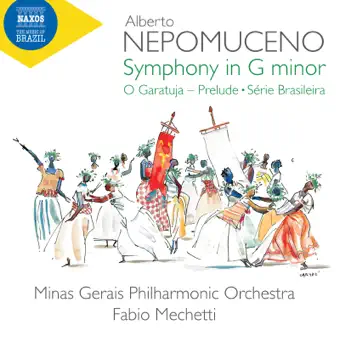mei 2019
Nepomuceno: Symphony in G Minor, O Garatuja Prelude & Série brasileira
Minas Gerais Philharmonic Orchestra o.l.v. Fabio Mechetti
Een veelbelovende manier om een 30-disc tellend overzicht van Braziliaanse muziek uit Naxos te beginnen – hopelijk een vol met ontdekkingen zoals deze.

Hoewel hij buiten zijn geboorteland vrijwel onbekend is, is Alberto Nepomuceno (1864-1920) een van de grootheden van de Braziliaanse muziek. Hij componeerde zijn Série Brasileira (‘Braziliaanse Suite’, 1891) terwijl hij studeerde bij Brahms’ vriend Heinrich von Herzongenberg in Berlijn. De suite in vier delen is absoluut verrukkelijk en op zijn eigen manier behoorlijk origineel. Nepomuceno’s invloeden zijn duidelijk zichtbaar: de weergave van de dageraad in de bergen in het openingsdeel lijkt te zijn gebaseerd op de ‘Scène aux champs’ uit Berlioz’ Symphonie fantastique en Wagners Forest Murmurs. Toch kijkt de muziek ook vooruit, en soms op verrassende manieren, zoals op 2'13" met zijn geurige vooruitwijzing naar Debussy's toonschildering van de dageraad in La mer. In het derde deel roept de wiegende duizeligheid eenvoudig en effectief de lome charme op van een dutje in een hangmat, terwijl de krachtige, gesyncopeerde ritmes van de laatste Batuque - ontleend aan een Afro-Braziliaanse dans - anders zijn dan alles in de Europese muziek van die tijd (de dichtstbijzijnde parallel is misschien Gottschalks A Night in the Tropics uit 1859).
Ik vind de suite veel succesvoller dan de g-mineursymfonie (1893), hoewel die laatste bovenaan de cd-hoes staat. Het werd geschreven rond de tijd dat Nepomuceno trouwde met een leerling van Grieg en bevriend raakte met de Noorse componist. De achterkant van de cd trompettert de invloed van Brahms, en hoewel er enkele duidelijk Brahmsiaanse momenten zijn - het spel van twee tegen drie in het mooie tweede thema van het Andante quasi adagio bijvoorbeeld – er is net zoveel Schumann als Wagner. Ik vind de onverwachte mix van Beethoven en Bizet in het Scherzo wel wat, maar over het algemeen is er niet genoeg van Nepomuceno zelf.
Het gebrek aan individualiteit is vooral merkbaar als je kijkt naar het levendige preludium van O Garatuja (1904), Nepomuceno’s onvoltooide komische opera. Hier dansen de ritmes, is het door folklore beïnvloede melodieuze materiaal fris en streelt een rijkdom aan harmonische en kleurrijke details het oor. Het hele programma wordt met panache gespeeld door de Minas Gerais Philharmonic, die veel gepolijster en volwassener klinken dan je zou verwachten van een orkest dat pas tien jaar geleden is opgericht.
Dit is het eerste deel van wat een 30-discs tellend overzicht van Braziliaanse muziek belooft te worden, een gezamenlijk project van Naxos en het Braziliaanse ministerie van Buitenlandse Zaken. Als volgende volumes de hoge standaarden die hier te horen zijn, behouden, hebben we veel om naar uit te kijken. Dringend aanbevolen.

Although virtually unknown outside his native land, Alberto Nepomuceno (1864-1920) is one of the luminaries of Brazilian music. He composed his Série Brasileira (‘Brazilian Suite’, 1891) while studying with Brahms’s friend Heinrich von Herzongenberg in Berlin. The four-movement suite is absolutely delightful and quite original in its way. Nepomuceno’s influences are readily apparent: the opening movement’s depiction of dawn in the mountains seems to draw on the ‘Scène aux champs’ from Berlioz’s Symphonie fantastique as well as Wagner’s Forest Murmurs. Yet the music also looks ahead, and sometimes in startling ways, as at 2'13" with its fragrant foreshadowing of Debussy’s tone-painting of daybreak in La mer. In the third movement, lilting wooziness simply and effectively evokes the languid charm of napping in a hammock, while the final Batuque’s vigorous, syncopated rhythms – drawn from an Afro Brazilian dance – is unlike anything in European music at that time (the closest parallel might be Gottschalk’s A Night in the Tropics of 1859).
I find the suite far more successful than the G minor Symphony (1893), although the latter gets top billing on the CD cover. It was written around the time Nepomuceno married a student of Grieg’s and was befriended by the Norwegian composer. The back of the disc trumpets Brahms’s influence, and although there are some distinctly Brahmsian moments – the play of two against three in the lovely second theme of the Andante quasi adagio, for instance – there’s just as much Schumann and Wagner. I rather like the unexpected mix of Beethoven and Bizet in the Scherzo but in general there’s not quite enough of Nepomuceno himself.
The lack of individuality is especially noticeable when one turns to the lively prelude to O Garatuja (1904), Nepomuceno’s unfinished comic opera. Here, the rhythms dance, the folk-inflected melodic material is fresh, and a wealth of harmonic and colouristic detail tickles the ear. The entire programme is played with panache by the Minas Gerais Philharmonic, who sound far more polished and mature than one would expect from an orchestra founded just a decade ago.
This is the first instalment in what’s promised to be a 30-disc survey of Brazilian music, a joint project between Naxos and the Brazilian Ministry of Foreign Affairs. If subsequent volumes maintain the high standards heard here, we have a lot to look forward to. Urgently recommended.
